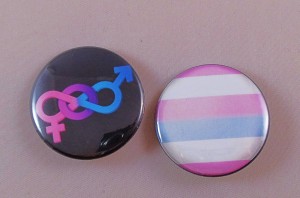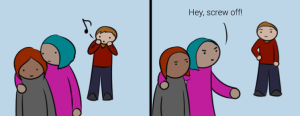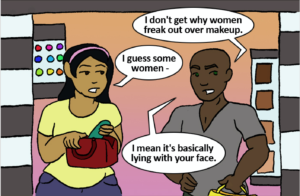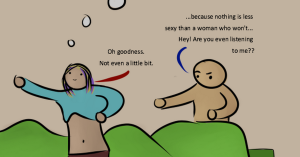
Source: Etsy
You may have noticed that here at Everyday Feminism, our queer-and-trans section is labeled “LGBTQIA.” And while “LGBTQ” might be familiar to a lot of you, the added “IA” often isn’t.
And while we’ve covered the A – which stands for asexual – a few times, we haven’t really given you a lot of resources on the I. And we want to.
Intersex is one of the often-left out categories of LGBTQIAP when it’s usually just abbreviated as LGBT. The QIAP is often ignored completely or briefly covered, but people who have these identities are marginalized not only in society, but also often within LGBTQIAP spaces themselves!
So let’s break it down.
What Is Intersex?
According to the Intersex Society of North America, “intersex is a general term used for a variety of conditions in which a person is born with a reproductive or sexual anatomy that doesn’t seem to fit the typical definitions of female or male.”
This means that anything from your genitalia, gonads (ovaries or testes), chromosomes, or reproductive systems are not completely in alignment with one gender assignment or the other.
You could have XXX chromosomes; be born without a uterus and ovaries; be born with a uterus, ovaries, and a penis; or have a clitoris that is extremely enlarged, resembling a small penis.
And all of these conditions? Yup! They fall under intersex.
Intersex shows how diverse biology can really be, which is really cool.
We often assume only two biological possibilities when it comes to someone’s sex, but just like with gender, there are actually ranges of possibilities.
How Many People Are Intersex?
The short answer: We don’t know.
The long answer: It’s hard to get accurate numbers — especially because many doctors will perform corrective surgery on ambiguous genitalia shortly after birth, and sometimes without the parents’ permission!
Talk about the power of the gender binary!
Intersex is also a complex identity and isn’t always obvious.
For example, you could have a different chromosomal make up than XX (bio-female) or XY (bio-male) and not know it. I mean, seriously, how many of us have really had chromosomal testing?
Even estimations are all over the board. Some research has pointed to 1-in-2000 births in the US, but this research is based in the status quo of the medical field, which has historically (and still is) based in this thinking. The most liberal of estimates has placed the number around 1%.
How Is It Treated?
Usually someone’s intersex identity is discovered when they are born (but not always, since many intersex conditions are chromosomal), with their genitalia appearing to be ambiguous.
Doctors operate out of a concealed-centered method of care, which means that intersex is treated as an abnormality that must be corrected. This usually results in “corrective” surgery that will result in the infant being assigned one of the two socially accepted sexes.
Oftentimes, doctors do not even inform the infant’s parents that they are performing surgery on their baby’s genitalia.
This is obviously problematic and this entire model of care is based in normalization and suppression.
It assumes that gender or sex can never fall outside of the binary we’ve created and that any bodies that challenge this must be changed to conform.
Not to mention that this model has resulted in a lot of psychological trauma for both parents and children.
So can it be treated? Is it? Surely.
But should it be? We’d argue that that should be left up to the person with the body!
In the meantime, as a society, we need to learn how to be more accepting (and even welcoming) of all non-binary conditions and identities!
Why Is No One Talking about This?
The medical community has suppressed these conversations.
The concealed-centered method of care forces intersex into silence. Since it’s viewed as a “problem” that needs to be “dealt with” before the child can even walk or talk, there is little room left for engagement. Many patients are even lied to about their conditions and not given medically accurate information.
Since there has been a lot of shame around intersex, it’s lived under the dark guise of quietness.
But luckily, that is starting to change.
What Does This Have to Do with Feminism?
A lot. In fact, everything.
The existence of intersex is yet another example that eradicates the gender binary.
Feminism has acknowledged how gendered expectations hurt all of us and keeps up divided in two very unnatural, arbitrary, and even harmful boxes of “man” and “woman.”
And as great as we try to be at acknowledging differences in identities and experiences, as feminists, we also need to be clear that not even biology is stable.
It’s also important to recognize the intersection of intersex identities in the lives of women and the social construction of womanhood.
Part of the very conservative estimates of intersex is the fact that doctors are under-diagnosing it.
It’s more common to assign someone who is intersex as female than male (often cited as due to the comparative ease of the surgical procedure to create a vulva), and this isn’t simply a product of biological realities. It is part of the bias that is Western medical practice.
It’s thought that doctors are more willing to assign someone’s sex as female because women can move more fluidly within our gender constructs, while men are forced into more masculine roles and face consequences if they ever veer towards femininity.
Since so much emphasis is placed on a man’s penis (and men having a penis in the first place, which is another topic of conversation!), if someone is born with one that is seen as abnormal, their masculinity is already threatened.
This all comes back to misogyny and our society’s messed up ideas about gender.
So we all have a stake in the reverence of intersex.
What Can We Do?
There’s a lot of activism we can participate in and pioneer around intersex.
There are many organizations that exist that are working for intersex rights, recognition, and inclusion into their marginalized place in the LGBT movement.
The Intersex Society of North America (whose information helped me to write a lot of this piece!), Intersex in America, OII Intersex Network, Advocates for Informed Choice, and Accord Alliance are good places to start.
You can also start talking about intersex and advocating for intersex rights as a part of human rights.
There are still many medical professionals and doctors who are trying to eradicate intersex by encouraging women who are carrying a suspected intersex child to abort or by offering them hormonal treatments during pregnancy to change their child’s genitalia. We can lobby to change this!
Educating yourself is also important.
You can learn more about intersex by checking out some of these books on the subject or by watching this documentary about David Reimer, one of the most famous cases of an intersex identity that shows the problematic nature of the medical communities treatment and the consequences of poor and abusive care.
The more we start to talk about intersex and say no to shame and silence, the more we can amplify the voices of the intersex community.
***
Intersex identities exist. And we need to start recognizing them.
Please share this article to raise awareness about intersex and educate others as to why they, too, should start caring.
[do_widget id=”text-101″]
Want to discuss this further? Visit our online forum and start a post!
Erin McKelle is a Contributing Writer for Everyday Feminism. She’s an e-activist, video blogger, student, and non-profit advocate who has launched several projects, including Fearless Feminism and Consent is Sexy. In her spare time, Erin enjoys reading, writing bad poetry, drawing, politics and reality TV. You can visit her site here find her blogging at Fearless Feminism, Facts About Feminism, and Period Positive. Follow her on Twitter @ErinMckelle and read her articles here.
Search our 3000+ articles!
Read our articles about:
Our online racial justice training
Used by hundreds of universities, non-profits, and businesses.
Click to learn more




















